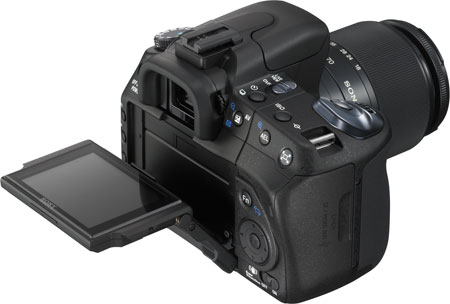

The adjustment wheel, used for altering exposure settings, is quite small and rather stiff, making it difficult to operate quickly and smoothly. The gap between the handgrip and the side of the lens mount is very narrow and anyone with larger fingers (like me) will find it a bit cramped, and will also find that their fingernails leave white scratch marks on the matt black plastic finish. The camera handles well and is comfortable and secure to hold, but I do have a couple of comments. Given the camera’s extremely high maximum resolution it is possible to crop and enlarge the image and still get a good picture, but it’s still no substitute for using a higher magnification lens. In other words it’s yet another new name for our old friend digital zoom. This is available only in live view mode, and magnifies the image by either 1.4x or 2x. The control layout is almost identical to the A200, excepting the addition of a slider switch that activated the live monitor view and closes a shutter inside the viewfinder, and a extra button for the “Smart Teleconverter” mode. Some of that is accounted for by the monitor screen, which is mounted on a two-way hinge, allowing it to tilt 45 degrees downwards or 90 degrees upward. It is a relatively small camera, measuring 130.8 x 98.5 x 74.7mm, and at 582g it is less than 40g heavier than the A200. It is made of plastic, but the rounded shape feels very strong and build quality is at least as good as any of the competition. The A350 shares the same body as the A200 and A300.
#Sony a200 liveview full
Sony’s solution is faster, more effective and much more useful, enabling full autofocus function in live view mode. Competitor DSLRs that offer live view have either simpler and slower contrast-detection AF systems when in live view mode, or have to temporarily flip the reflex mirror down to use their phase-detection AF systems. However the A350 not only has live view, it also has a two-way tilting 2.7-inch 230k monitor and, more importantly, a fast nine-point TTL phase-detection autofocus system available in live view mode. Sony was a relatively late adopter of live monitor view for its digital SLRs, and both the A700 and A200 lack this feature. Of course sensor resolution isn’t the only criteria by which a camera should be judged, and the A350 has another important feature that sets it apart from the competition. Canon has a slightly closer match in the shape of the popular 12.2-megapixel EOS 450D (review coming soon) at £459.99 body only or £499.99 with an 18-55mm lens. Olympus offers the E-520 for £499.99 body-only or £549.99 with a Four-Thirds system 14-42mm lens, but again it is only 10 megapixels. Nikon’s closest competitor is the D80, currently £499 body only or £639.99 with an 18-70mm lens, but the D80 is only 10 megapixels. The A350 is currently priced at a very competitive £449.99 body-only, £499.99 with an 18-70mm zoom lens, or £649.99 as a two-lens kit with the addition of a 55-200mm zoom. Neither market leaders Canon nor second-placed Nikon has anything that directly competes in this band, which must be helping with Sony’s stated intent to overtake Nikon and put a serious dent in Canon’s seemingly unassailable lead. With a sensor resolution of 14.2-megapixels, the A350 occupies a relatively new band in the digital SLR market, along with the 14.6-megapixel, £800 Pentax K20D. There were two more models launched in March of this year, the Jessops-exclusive Alpha A300, currently £399.99 including an 18-70mm lens, and today’s review camera, the Alpha A350.
#Sony a200 liveview professional
We reviewed the flagship Alpha A700, a 12-megapixel professional model in November of last year, and in February we took a look at the Alpha A200, the 10-megapixel entry-level model currently priced at £300 with an 18-70mm lens. Sony’s campaign to cut itself a bigger share of the lucrative digital SLR market continues to gather pace.


 0 kommentar(er)
0 kommentar(er)
